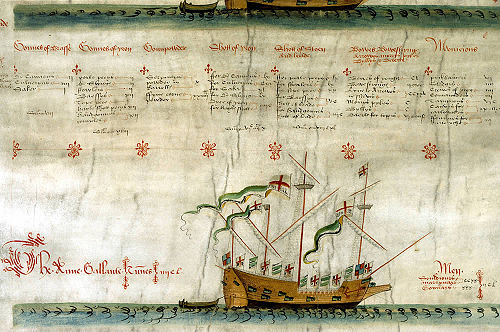Anthony Roll

Contents
- First roll — Carracks
- Second roll — Galleasses
- Third roll — Pinnaces and rowbarges
Notes on use of numerals and measurements
The numbers in the rolls are written in Roman numerals, though with more complicated formulas for certain large numbers than those used today. The letter "i", standing for one (1), is written as "j" when standing alone or at the end of a sequence of numbers, as in "viij" (8) or "xij" (12). Four (4) is written as "iiij" rather than "iv". The number five (5) is written as "v", ten (10) as "x" and fifty (50) as "l".
A superscript "c" means multiplication by one hundred (100), as in "iijc" (3 x 100 = 300), though this is occasionally also written as "ccc". A superscript "ml" means multiplication by a thousand (1000), as in "vmliijc" (5 x 1000 + (3 x 100) = 5,300). The number eighty (80) is written as "xx" (20) multiplied by "iiij" (4), the former on top of the latter, as in "". This can also included in more complex numbers such as "ixcix" (9 x 100 + (4 x 20) + 9 = 989).
A superscript "lb" stands for pounds, used as a measurement only for gunpowder. Bowstrings are given in gross ("groce"), twelve dozens, or 144.
![]()
This work was published before January 1, 1930, and is in the public domain worldwide because the author died at least 100 years ago.
Public domainPublic domainfalsefalse

